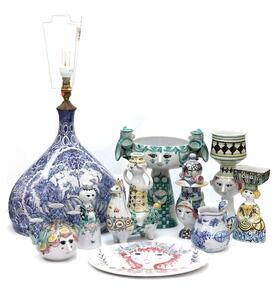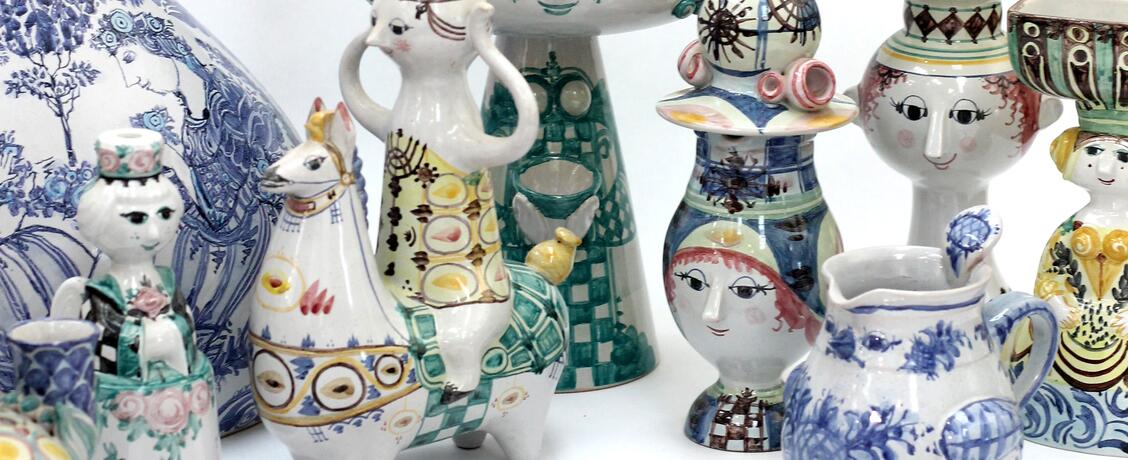No Disdain for this Dane in Diss!
No Disdain for this Dane in Diss!
by Elizabeth Talbot
Much has been shared in celebration of Danish artist Bjørn Wiinblad (1918 – 2006), the multi-talented creative tour-de-force with immense business-sense. Articles have been written, books published, and popular exhibitions staged, both during his lifetime and since. He is identified as having special joie de vivre and energy that are unique, not only in Danish art and design, but in international art and design, also.
His distinctive style and illustrations will be familiar to many, even if his name is not. He became world famous for his imaginative drawings and decorations filled with romantic girls, legendary figures and wonderful patterns. Eventually plates, bowls, cups, dishes, ashtrays and candleholders adorned with Wiinblad’s drawings came to be in every Dane's home because most people were able to afford these goods. His art reached ordinary people and that’s what he really wanted.
Bjørn Wiinblad was born in Copenhagen, to his mother Ebba, father Otto and sister Ulla. Unlike the rest of his family, Bjørn was not interested in discussing or pursuing politics, nor working for social reform. He was a dreamer who preferred to draw, paint, and play the recorder, finding joy in art and creativity, including writing short stories as he grew older. When he told his father he wanted to be an artist, his father insisted that he should first gain an education to ensure a job that would pay a reliable monthly income.
So, in 1935, Wiinblad began training as a typographer. Although he appreciated how sensible it was to master a craft, he did not enjoy typography. So, when he qualified as a typographer in 1940 and he could have begun a career as a printer or compositor in a newspaper, the aspect of illustration appealed to him more. Later the same year he began studying at the graphic school in the Royal Danish Academy of Fine Arts. Wiinblad began by following his professor Aksel Jørgensen’s tight graphic style, but soon his own imaginative creations began to evolve, including elf-like figures, women with almond-shaped eyes and beautiful floral displays. His talents were not limited to painting and drawing and in 1943 ,fellow student Lars Syberg introduced him to working with ceramics. Rather than being a fine potter, Wiinblad found his main skill was in design and decoration, and he was particularly enthusiastic about working with the old cow horn technique, whereby a cow's horn is filled with colour and applied to a pot or dish, giving a particularly fine line and requiring a very steady hand.
Wiinblad graduated from the Royal Danish Academy of Fine Arts in 1945, and immediately debuted with a comprehensive exhibition in the small Binger gallery in Palægade in Copenhagen. His style differed significantly from the Danish design style of the era and it proved very popular. He had gone on to apply his designs to a wide range of materials and formats, including book-illustration, theatre set design and poster art, and it all proved a resounding success. The inaugural exhibition became a major attraction, and Wiinblad not only sold art worth 1000 kroner from day one, but through it he also met a number of influential people who could extend his production of ceramics and posters. These included Jacob E. Bang, who had just become creative director of the small pottery factory, Nymølle. He quickly became friends with Wiinblad, and soon hired him to work for Nymølle. This collaboration lasted around 30 years and Wiinblad's work from this producer is perhaps some of his best known to the widest audience.
In the early 1950s, Wiinblad founded and established his own ceramic workshop in Kongens Lyngby. He embraced every medium and he loved bright colours. He relished the discipline required for hand-making pieces but was comfortable with the concept of mass-production. He won many awards and accolades over his lifetime, including a silver medal in 1955 for a collaboration with potters Nathalie Krebs and Axel Salto at the first international ceramic festival in Cannes.
Then, in 1957, Wiinblad was hired as a designer by the German design company Rosenthal AG. He was their leading light for over 30 years and worked with the company for almost 50 years; some of Wiinblad’s most famous works from this time are Romane, Lotus and The Magic Flute. In the early 1960's he decorated Tivoli’s restaurant, Færgekroen, and started working with decoration abroad – including hotels like the London Hilton. In 1965, Wiinblad created a series of 12 monthly plates for Nymølle, which have become iconic, before moving into The Blue House in Kongens Lyngby in 1966. This property would be his home for the rest of his life, serve as a workshop for him and people he worked with, and has become a living museum and an accessible creative space since his death.
Wiinblad's energies seemed to know no bounds. In 1971, he opened his own business, Bjørn Wiinblads Hus, in Copenhagen, whilst in 1976, not only did he become co-owner of the Nymølle Ceramic Factory, but he also received a knighthood from Queen Margrethe of Dannebrog. At this point, Wiinblad’s status as a manufacturer of collectable items gained huge momentum.
He continued to exhibit, win awards, and create. Combined with his good business sense, he became one of the wealthiest Danish artists of the 1960s and 1970s. Ceramic pieces featuring his designs are in collections including the Museum of Modern Art in New York, the National Museum in Stockholm, and the Museum of Copenhagen.
Wiinblad was so prolific that his ceramics are regularly found on the resale market, and pieces from the Nymølle and Rosenthal factories can be bought at very accessible prices. However, what is less common is to find a significant collection being offered to the market. TW Gaze is delighted to have been instructed to sell an extensive private collection which has been honed over many years and which contains some wonderful early rarities. These include a pair of green centaurs (as illustrated in " Bjørn Wiinblad - An Ouvre of Joy and Delight" from the Museum of International Ceramic Art), white opera figures, and red and blue Susanne figures with birds.
The vendor, who lives in East Anglia, recalls: "We were gifted a lovely pair of Rosenthal candlesticks as a housewarming present in the 80’s (which I still have!). The same friends also gifted me a Bjorn Wiinblad bottle vase when they returned to Denmark around 10 years later. It was this that piqued my curiosity, as (being) not like anything I’d come across before. I managed to find information on this incredible artist who was commissioned to provide for so many important establishments and venues world wide. However it was the quirkiness of much of his pottery that really appealed to me, I find it very joyous! I gradually managed to build up a collection of varied pieces, which I only stopped in around 2004 due to lack of space!"
"Now with future plans, I know I have to scale down my collection greatly, although I have kept a few of my favourite pieces, including of course the original gifts from our Danish Friends. Time for someone else to be their caretaker and enjoy them as much as I have, hopefully!"
There will be over 50 lots of Bjørn Wiinblad offered from the same source, including early and scarce works, with estimates ranging from £20 - 300. James Bassam, Modern Design specialist at Diss Auction Rooms says "This is the best collection of Bjørn Wiinblad's work I have ever seen. Individual pieces are attractive and appealing, but quality pieces viewed in quantity, not only illustrate the fun and humour of the artist, but also reiterates his pure genius as a designer."
Sale date 12th November at 10am
Viewing Thursday 7th November 1-7pm, Friday 8th 9am-12noon, Monday 11th from 10am-4pm

